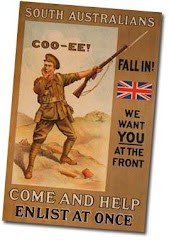
Len Moody was born in Huddersfield, Yorkshire, in 1887. It is not clear when he emigrated to Australia, but he was living in Blackwood just before the war. He was very active in the Blackwood community, being the correspondence secretary of the Blackwood, Belair and Coromandel Club and secretary of that club's literary society, and a member of the Blackwood Rifle Club. He was well-known as a joker and talented pianist, and was a master of ceremonies at many Club events such as dances.
Len enlisted on 30 June 1915, and gave his occupation as architect, and his next-of-kin as his sister, who still lived in Yorkshire. He joined Ack Company of the 32nd (SA/WA) Battalion and was promoted to the rank of corporal well before the battalion sailed for Europe, probably as a result of his age and leadership skills which must have been obvious from the day he joined.
The battalion sailed in November 1915, and after a short stop in Egypt during which he was hospitalised for three weeks with dysentery, they disembarked in the south of France and entrained for Calais then sailed to England for training at Codford. The battalion returned to France in late June 1916, and were initially allocated to the so-called 'nursery sector' around Armentieres.
On the evening of 19 July 1916, three days after entering the front-line for the first time, the 32nd Battalion attacked the German trenches near Fromelles. Ack Company were in the first wave, and initially captured the German trenches opposite, but during the early morning of 20 July became surrounded, and had to charge back to their start trenches to avoid capture. Many were killed, wounded and taken prisoner, the 32nd Battalion suffering 718 casualties, more than 90% of the unit fighting strength. The 8th Brigade and the 5th Division, of which it was part, were taken out of the line as a result, and could not be used again for offensive operations until well into 1917. The day after the Battle of Fromelles, in the wake of the long casualty lists, Len was promoted to lance-sergeant.
A month later, Len was hospitalised for several weeks, and then promoted to sergeant in October 1916. After several more weeks in hospital with influenza in December 1916, he rejoined the unit on Christmas Eve 1916.
In early 1917, the 32nd Battalion was involved in the follow-up of the German withdrawal to the Hindenburg line. In July 1917, Len was promoted to company quartermaster sergeant (or CQMS), responsible for the practical aspects of the supply of Ack Company with rations, ammunition and water (and rum). The only major battle the unit was closely involved in during 1917 was the Battle of Polygon Wood in Belgium on 26 September.
The 5th Division was in reserve during the German Spring Offensive of 1918, but it and the 32nd Battalion were involved in the Battle of Amiens in August 1918, and the operations against the Hindenburg Line that followed. Notable amongst these was the battalion's role in the capture of the area around Peronne in early September 1918.
After his discharge in Adelaide in July 1919, Len married Marion and lived in Gosford, NSW, where he was known as one of the 'Big Four' local identities. He was secretary of the 'Jusfrute' factory in West Gosford in the 1930's, and trustee and secretary of the Brisbane Water Returned Soldiers and Citizens Club in 1940. He enlisted as a private in the Volunteer Defence Corps during the Second World War, serving between 1943 and 1945.
Len visited Adelaide to attend battalion re-unions and march with his battalion on ANZAC Day. He died in 1966. His name is inscribed on the Blackwood Memorial.
Photograph: 'Second to None, A Memorial History of the 32nd Battalion AIF 1915-1919', p. 216







